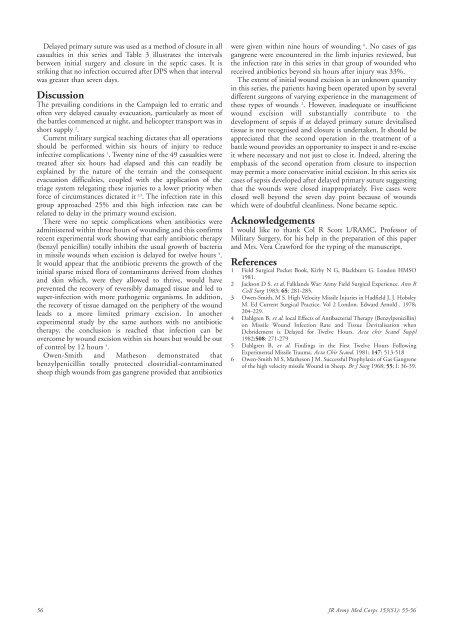Falklands war 25TH anniversarY - Boekje Pienter
Falklands war 25TH anniversarY - Boekje Pienter
Falklands war 25TH anniversarY - Boekje Pienter
Create successful ePaper yourself
Turn your PDF publications into a flip-book with our unique Google optimized e-Paper software.
Delayed primary suture was used as a method of closure in all<br />
casualties in this series and Table 3 illustrates the intervals<br />
between initial surgery and closure in the septic cases. It is<br />
striking that no infection occurred after DPS when that interval<br />
was greater than seven days.<br />
Discussion<br />
The prevailing conditions in the Campaign led to erratic and<br />
often very delayed casualty evacuation, particularly as most of<br />
the battles commenced at night, and helicopter transport was in<br />
short supply 2 .<br />
Current military surgical teaching dictates that all operations<br />
should be performed within six hours of injury to reduce<br />
infective complications 1 . Twenty nine of the 49 casualties were<br />
treated after six hours had elapsed and this can readily be<br />
explained by the nature of the terrain and the consequent<br />
evacuation difficulties, coupled with the application of the<br />
triage system relegating these injuries to a lower priority when<br />
force of circumstances dictated it 1,3 . The infection rate in this<br />
group approached 25% and this high infection rate can be<br />
related to delay in the primary wound excision.<br />
There were no septic complications when antibiotics were<br />
administered within three hours of wounding and this confirms<br />
recent experimental work showing that early antibiotic therapy<br />
(benzyl penicillin) totally inhibits the usual growth of bacteria<br />
in missile wounds when excision is delayed for twelve hours 4 .<br />
It would appear that the antibiotic prevents the growth of the<br />
initial sparse mixed flora of contaminants derived from clothes<br />
and skin which, were they allowed to thrive, would have<br />
prevented the recovery of reversibly damaged tissue and led to<br />
super-infection with more pathogenic organisms. In addition,<br />
the recovery of tissue damaged on the periphery of the wound<br />
leads to a more limited primary excision. In another<br />
experimental study by the same authors with no antibiotic<br />
therapy, the conclusion is reached that infection can be<br />
overcome by wound excision within six hours but would be out<br />
of control by 12 hours 5 .<br />
Owen-Smith and Matheson demonstrated that<br />
benzylpenicillin totally protected clostridial-contaminated<br />
sheep thigh wounds from gas gangrene provided that antibiotics<br />
were given within nine hours of wounding 6 . No cases of gas<br />
gangrene were encountered in the limb injuries reviewed, but<br />
the infection rate in this series in that group of wounded who<br />
received antibiotics beyond six hours after injury was 33%.<br />
The extent of initial wound excision is an unknown quantity<br />
in this series, the patients having been operated upon by several<br />
different surgeons of varying experience in the management of<br />
these types of wounds 2 . However, inadequate or insufficient<br />
wound excision will substantially contribute to the<br />
development of sepsis if at delayed primary suture devitalised<br />
tissue is not recognised and closure is undertaken. It should be<br />
appreciated that the second operation in the treatment of a<br />
battle wound provides an opportunity to inspect it and re-excise<br />
it where necessary and not just to close it. Indeed, altering the<br />
emphasis of the second operation from closure to inspection<br />
may permit a more conservative initial excision. In this series six<br />
cases of sepsis developed after delayed primary suture suggesting<br />
that the wounds were closed inappropriately. Five cases were<br />
closed well beyond the seven day point because of wounds<br />
which were of doubtful cleanliness. None became septic.<br />
Acknowledgements<br />
I would like to thank Col R Scott L/RAMC, Professor of<br />
Military Surgery, for his help in the preparation of this paper<br />
and Mrs. Vera Crawford for the typing of the manuscript.<br />
References<br />
1 Field Surgical Pocket Book, Kirby N G, Blackburn G. London HMSO<br />
1981.<br />
2 Jackson D S. et al. <strong>Falklands</strong> War: Army Field Surgical Experience. Ann R<br />
Coll Surg 1983; 65: 281-285.<br />
3 Owen-Smith, M S. High Velocity Missile Injuries in Hadfield J, J. Hobsley<br />
M. Ed Current Surgical Practice. Vol 2 London. Ed<strong>war</strong>d Arnold . 1978;<br />
204-229.<br />
4 Dahlgren B, et al. local Effects of Antibacterial Therapy (Benzylpenicillin)<br />
on Missile Wound Infection Rate and Tissue Devitalisation when<br />
Debridement is Delayed for Twelve Hours. Acta chir Scand Suppl<br />
1982;508: 271-279<br />
5 Dahlgren B, et al. Findings in the First Twelve Hours Following<br />
Experimental Missile Trauma. Acta Chir Scand. 1981; 147: 513-518<br />
6 Owen-Smith M S, Matheson J M. Successful Prophylaxis of Gas Gangrene<br />
of the high velocity missile Wound in Sheep. Br J Surg 1968; 55; I: 36-39.<br />
56 JR Army Med Corps 153(S1): 55-56

















